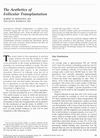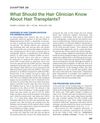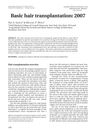Hair Restoration
August 2008
in “Facial Plastic Surgery Clinics of North America”

TLDR Hair restoration surgery redistributes existing hair to achieve a natural look, with visible regrowth in 3-4 months and rare complications, mostly aesthetic.
The document from 15 years ago discussed the evolution of hair restoration surgery, emphasizing the concept of donor dominance and the use of follicular unit transplantation for natural-looking results. The procedure involved two sessions, each with 1000 to 2500 grafts, separated by 6 to 12 months. The process included designing the hairline, preparing the donor site, grafting under local anesthesia, and postoperative care. Hair regrowth usually started to regenerate visible hair in 3 to 4 months. Complications were rare but could include patient anxiety, vasovagal reactions, hypertension, lidocaine toxicity, postoperative bleeding, and bacterial infection. Long-term complications were predominantly aesthetic in nature and involved poor graft survival, poor design, and inappropriate patient selection. The document emphasized that hair restoration is about redistributing existing hair rather than creating new hair, and achieving optical density rather than original density is the goal.
View this study on linkinghub.elsevier.com →
Cited in this study

research The Aesthetics of Follicular Transplantation
The document concludes that good cosmetic outcomes in hair transplantation depend on the surgeon's artistic skill and careful planning.
Related

research Using Nonscalp Hair in Scalp Hair Restoration—Theory and Execution
You can use hair from other parts of the body for scalp hair restoration.

research What Should the Hair Clinician Know About Hair Transplants?
Hair transplants are effective for male and female pattern baldness, have evolved in technique, and require careful planning for natural results and managing complications.

research The Use of Body Hair with Scalp Hair for “Combination Grafting” to Enhance Visual Density of Hair Transplantation and Increase Coverage in Advanced Alopecia
Using body hair with scalp hair for hair transplants improves density and coverage in severe hair loss cases.

research Body to scalp: Evolving trends in body hair transplantation
Body hair transplants can treat baldness but differ from scalp hair and need more research on long-term results and side effects.

research Body Hair Transplant by Follicular Unit Extraction: My Experience With 122 Patients
Body hair transplantation is an effective method for restoring hair in people with severe baldness and limited scalp donor hair.

research Use of body and beard donor hair in surgical treatment of androgenic alopecia
Body and beard hair can be used for hair transplants in baldness treatment but keep their original color and curl.

research Hair Restoration
Hair restoration surgery redistributes existing hair to achieve a natural look, with visible regrowth in 3-4 months and rare complications, mostly aesthetic.

research Basic hair transplantation: 2007
Hair transplantation has improved with techniques that increase graft survival and patient satisfaction for more natural results.

research Use of Micrografts and Minigrafts in Hair Restoration
Micrografts and minigrafts for hair restoration provide high patient satisfaction and can cover large areas of hair loss, including sideburns, eyebrows, and beards.